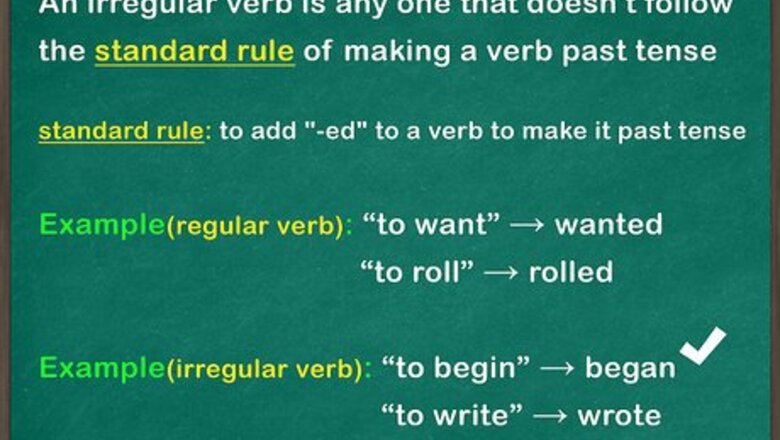
views
Grouping Irregular Verbs
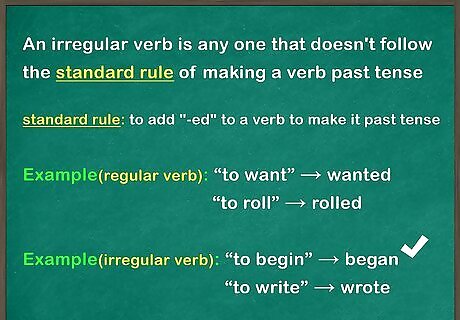
Learn the definition of irregular verbs. To truly learn irregular verbs, you need to first understand what makes a verb irregular. An irregular verb is any one that doesn't follow the standard rule of making a verb past tense. The standard rule is to add "-ed" to a verb to make it past tense. For instance, a regular verb is "to want." To make it past tense, you add "-ed" to it, making it "wanted." "Wanted" is also the past participle. The past participle is what usually follows "have" or "has" in English, such as "I have wanted." An irregular verb doesn't follow this rule. For instance, "to begin" is an irregular verb. The past tense is "began," while the past participle is "begun." Irregular verbs don't follow any specific patterns. Some irregular verbs are different in American and British English. Try to focus on one or the other when you're learning irregular verbs. For instance, British English adds "t" at the end of more verbs to make them past tense, such as "dreamt."
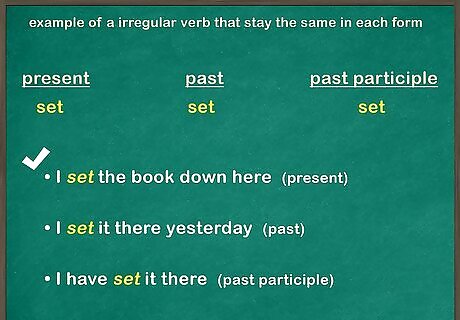
Understand that some irregular verbs stay the same in each form. A verb like "set" is the same in the infinitive, the past tense, and the past participle. That means that you don't change it all for these three forms. You would say, "I set the book down here" (present), "I set it there yesterday" (past tense), and "I have set it there" (past participle). Other verbs that fall into this category include the following: let, spread, shed, thrust, split, upset, hurt, shut, put, burst, hit, cut, and cost.
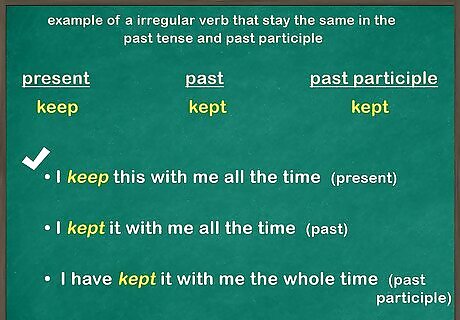
Look for verbs that stay the same in the past tense and past participle. Other verbs change when going from present tense to past tense. However, they stay the same when moving from the past tense to the past participle. For example, "keep" and "shoot" are examples of these verbs. For "keep," you'd say, "I keep this with me all the time" (present), "I kept it with me all the time" (past tense), or "I have kept it with me the whole time" (past participle). These verbs fall into several patterns. Some verbs change vowels, such as "sit" ("sat") and "get" ("got"). Some verbs add "t" at the end, often exchanged for a vowel or consonant elsewhere in the word. Examples include "feel" ("felt"), "lend" ("lent"), "keep" ("kept"), or "build" ("built"). Other verbs add "d," sometimes with an extra vowel or vowel/consonant changes, such as "pay" ("paid"), "say" ("said"), "sell" ("sold"), "tell" ("told"), "hear" ("heard"), and "stand" ("stood"). Verbs like "bring," "buy," "fight," and "think" change to "brought," "bought," "fought," and "thought." These verbs add "ght."
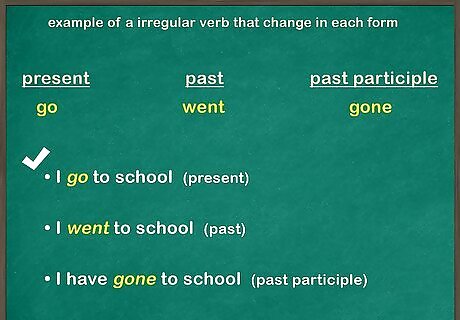
Notice that some irregular verbs change in each form. Some verbs have a different form for present, past, and past participle, making them all the harder to learn! Unfortunately, this category includes some of the most common verbs, such as "be" and "go." For instance, for "to be," you'd say, "I am here" (present), "I was there" (past), and "I have been there" (past participle). In this category, some verbs take "-en" in the past participle, such as "break-broke-broken," "fall-fell-fallen," "ride-rode-ridden," "see-saw-seen," and "speak-spoke-spoken." Other verbs change the vowel to an "e" in the past tense and/or add "wn" in the past participle. Examples include "flow-flew-flown," "draw-drew-drawn," "show-showed-shown," and "grow-grew-grown." Still others take different vowels in each form, such as "swim-swam-swum," "begin-began-begun," "sing-sang-sung," and "drink-drank-drunk."
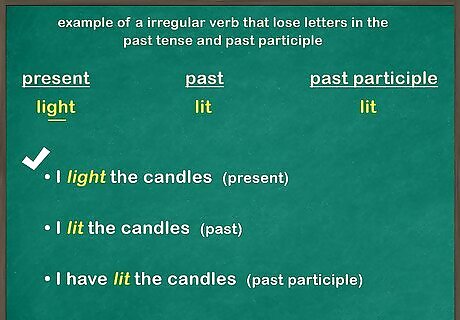
Know some verbs lose letters in the past tense and past participle. Most verbs become longer or stay the same length in the past tense. Verbs like "light" become shorter in the past tense and past participle ("lit"). That can confuse some learners. "Shoot" is another example, as it becomes "shot" in the past and past participle.

Find an extensive irregular verb list. You can find some patterns in irregular verbs. However, you'll likely need to just memorize most of them. Start with a list of the most common irregular verbs, such as these two: http://www.giuseppeveronese.it/public/231/2478_Common-Irregular-Verbs-Grouped.pdf or http://www.chompchomp.com/rules/irregularrules01.htm. Another good resource is https://owl.english.purdue.edu/owl/resource/605/01/.
Practicing Irregular Verbs
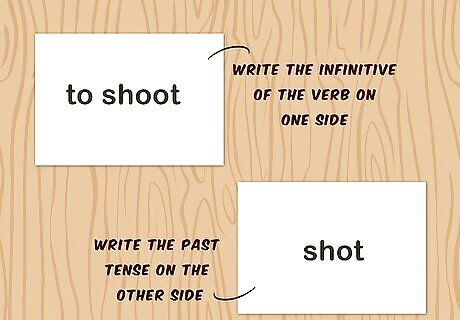
Make flash cards to help yourself remember. Write the infinitive of the verb on one side, which means "to" plus the present tense. On the other side, write the past tense of the word. Use the cards to quiz yourself. You could also place the past participle on the back as well.

Practice using irregular verbs in sentences. Each week, focus on a set number of irregular verbs, such as 10. Practice using each one in a sentence. Write a sentence each for the present tense, the past tense, and the past participle. Using irregular verbs in sentences will help solidify them in your mind.
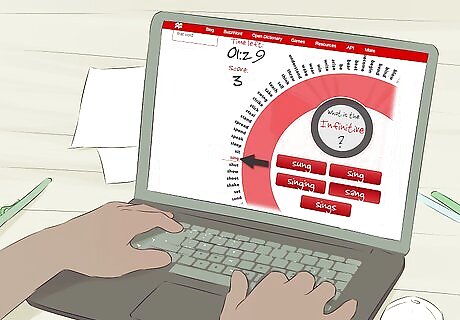
Play games online to practice irregular verbs. Use online resources to help you get in as much practice as possible. While most of the games are simple, they will help you become familiar with common irregular verbs. For instance, you can find an irregular verb game at https://www.macmillandictionary.com/us/verb_wheel/. Another option is http://eslgamesworld.com/members/games/ClassroomGames/Quizshow/Irregular%20Past%20Simple%20Quiz%20Show/index.html.
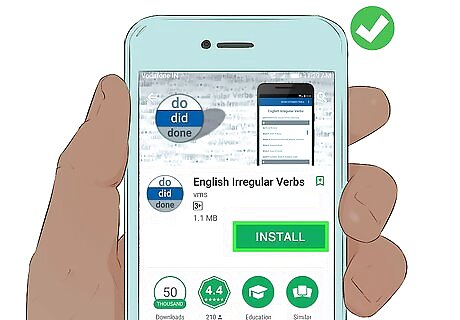
Download apps to learn irregular verbs. Some apps turn learning irregular verbs into a game. Once the app is on your phone or tablet, play the game to start reinforcing your verbs. For instance, try the app English Irregular Verbs.
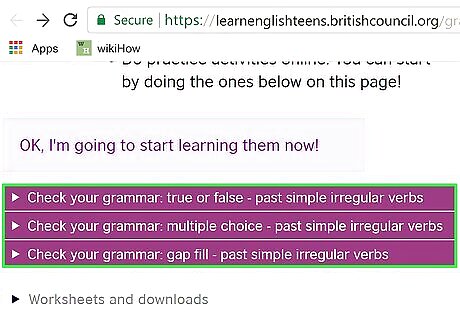
Try quizzes and tests online to see how much you know. Tests online may be multiple choice, or they may just ask you to fill in the past tense. Either way, they can help you see how much you've learned and how much you still need to learn. For instance, you can find quizzes at https://learnenglishteens.britishcouncil.org/grammar/a1-a2-grammar/past-simple-irregular-verbs or http://esl.fis.edu/grammar/verbs/5.htm.
Familiarizing Yourself with Usage
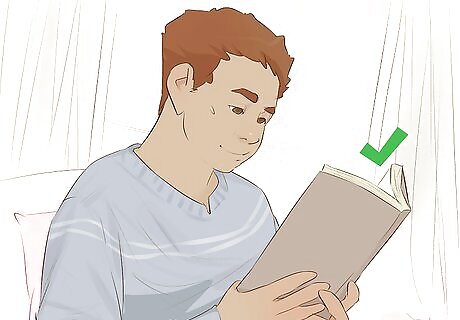
Read as much as you can. This step may seem simple, but reading is one of the best ways to learn irregular verbs. The more you read, the more irregular verbs will become second nature to you. It doesn't really matter what you read, as long as you're reading. Irregular verbs are everywhere.

Watch television or listen to podcasts. Hearing irregular verbs can also help you familiarize yourself with them. The more you hear them, the more likely you are to use them correctly when you speak. Try watching one of your favorite television shows in English at least once a day. You'll be learning more than you realize!

Make a note of irregular verbs when you see or hear them. As you're reading or listening, pay attention when irregular verbs are used. You'll notice them because the sentence will be in past tense, but the verb won't end in "-ed." Use context clues to help you. If the whole passage is in past tense, then the sentence you're reading is likely in past tense, too, even if the verb doesn't have "-ed" at the end.
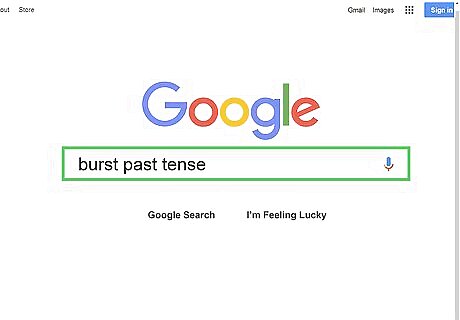
Look up words when you don't know the past tense. If you're unsure whether a verb is irregular or not, look it up in the dictionary. A dictionary entry will provide the past tense and past participle of the word so you can decide if it's irregular or regular. Some dictionaries only list the past tense if the verb is irregular.




















Comments
0 comment